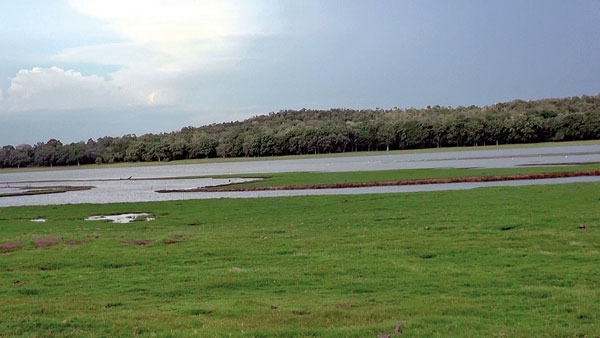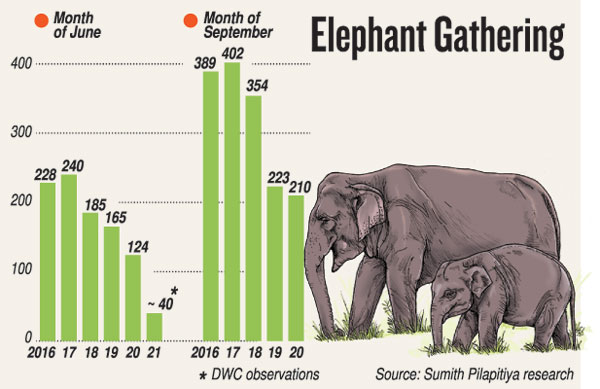News
‘The Gathering’ is in peril, warns wildlife expert

The annual spectacle: The 'Gathering' at Minneriya
Pointing out that human-induced, ‘unseasonal’ fluctuating water levels of the Minneriya tank in the dry season was having a direct impact on the number of elephants at this annual spectacle, Former DWC Director-General Dr. Sumith Pilapitiya pleads for a national policy to redress the issue.
Great danger stares the ‘Elephant Gathering’ at Minneriya in the face and requires urgent national level action before disaster ensues and plugs shut this valuable foreign-exchange earner.
An ‘early’ warning comes from a top researcher who has been studying elephant behaviour not only at the 8,800-hectare Minneriya National Park but also the Kaudulla National Park.
The numbers at ‘The Gathering’ have been dropping in the last few years from more than 400 wild elephants to fewer than 200 in September, stresses the former Director-General of the Department of Wlidlife Conservation (DWC), Dr. Sumith Pilapitiya who has been watching and recording the ‘signals, gestures and behaviour’ of these majestic animals since 2016.
‘The Gathering’ dubbed by Lonely Planet as one of the ‘10 Wildlife Wonders of the World’ takes place between June and October, with the high-point in September.

Water flowing into the Minneriya tank in the dry season of July 2019 through the 10ft-15ft deep canal which can be seen in the foreground. This canal is ‘brimming’ up to the grassland level even though it should have very little water in the dry season and is due to the ‘unseasonal’ discharge of water into Minneriya
Urging a “‘win-win” situation rather than a “lose-lose” situation, Dr. Pilapitiya reiterates that the drop in the number of elephants during ‘The Gathering’ has a direct link to the human-induced, ‘unseasonal’ fluctuating water levels of the Minneriya tank in the dry season in recent times.
“We need national policy on this national issue, bringing in the crucial sectoral stakeholders – the Irrigation Department, the Agriculture Department, the DWC and the tourism authorities – to an amicable understanding,” he pleads.
Not only does Dr. Pilapitiya cast light on the looming problem with facts and figures and not hype, he also looks at a solution which would be a ‘win-win’ for the farmers, the wild elephants and Sri Lanka.
Dr. Pilapitiya who has carried out counts of the elephants feeding on the Minneriya grasslands one day a month during the dry season since June 2016 each year, has also looked closely at anecdotal evidence and a study done by the late Dr. Charles Santiapillai in 2007. All evidence points to more than 400 elephants being part of ‘The Gathering’ in September.
The ‘natural system’ was working wonderfully, he says, until Moragahakanda came into the picture. The ‘unseasonal’ release of water from Moragahakanda in June-July starting in 2018 and continuing in 2019, 2020 and 2021 has confused the elephants.
Explaining that the Irrigation Department has assured the DWC that the reservoir (tank) level will not exceed 70% as that is the volume needed for the Yoda Ela which is on a higher level than Minneriya tank, to carry water to Kantale and the east, Dr. Pilapitiya’s observations record that “even a slight increase” in the water level triggers the unexplained movement of some herds of elephants. This is regardless of the available grasslands at that time.
Focusing on what is happening at ground level, he says that there is a “strong and inextricable link” between the dry season water releases into the Minneriya tank and the movement of several herds of elephants away from the Minneriya grasslands, even though around 40-50% of the grasslands are still exposed.
“A gradual but drastic reduction in elephant numbers has been observed in the Minneriya grasslands. The usual peak of around 400 elephants in September has become halved,” Dr. Pilapitiya cautions, pointing out that this could lead to a phenomenal loss of revenue from tourism, while also escalating the human elephant conflict (HEC).
There had been a disturbing six-fold rise in the HEC including property damage and crop-raiding, a study by the University of Colombo had found, the Sunday Times learns.
Referring to the situation in June 2021, he says that with the Minneriya tank water levels being much higher than normally observed at this time, there is only a sparse scattering of fewer than 50 elephants.
The elephants gather at Minneriya propelled by historical experience and are oblivious of human intentions and decisions, says Dr. Pilapitiya, urging prompt redress as otherwise ‘The Gathering’ is in peril, while also impacting on this elephant population.

| They come to feast on the tender grass, with water being an added boon The spectacular ‘Gathering’ happens as the waters of the beautiful Minneriya tank in the North Central Province, built by King Mahasen in the 3rd century AD, recede due to the dry season between June and October. The waters augmented by the rains fill the tank to capacity up to the edge of the forest from December to April, but begin retreating with releases for farming and as the dry season takes hold of the area. This sets off the renewal of life as the grass-bed which has been submerged begins its growth, fed by the sediment-rich soil. As the tender shoots of grass come up, carpeting the tank-bed, from different areas converge herds and herds of elephants big and small, to feed on the tasty morsels, with the boon of frolicking in the waters. Researcher Dr. Sumith Pilapitiya says that even though grass has less protein, when comparing mature and tender grass, the latter has a higher level of protein. So, the elephants are instinct-driven to come and feed on this grass as the forest loses fodder during the dry season. The water in the tank is just a secondary benefit. This scene of wild elephants with lots of babies as far as the eye can see holds the beholder in awe and has attracted thousands and thousands of tourists from abroad, filling the country’s coffers with foreign exchange, directly and indirectly.
| |
| A simple hydraulic engineering solution There is a simple hydraulic engineering solution to this crisis, without jeopardizing the interests of the farmers, the Sunday Times understands. The farmers in Kantale and the east need water for their cultivations during the dry season but do we need to “store” this large volume of water in the Minneriya tank, critically endangering ‘The Gathering’, asks Dr. Sumith Pilapitiya. He is convinced that Sri Lanka’s clever hydraulic engineers can come up with a solution to send in and release the water in such a way that there is no need to store this large volume either at Minneriya or Kaudulla tanks. Then everyone wins and ‘The Gathering’ continues.
|

